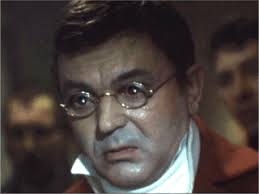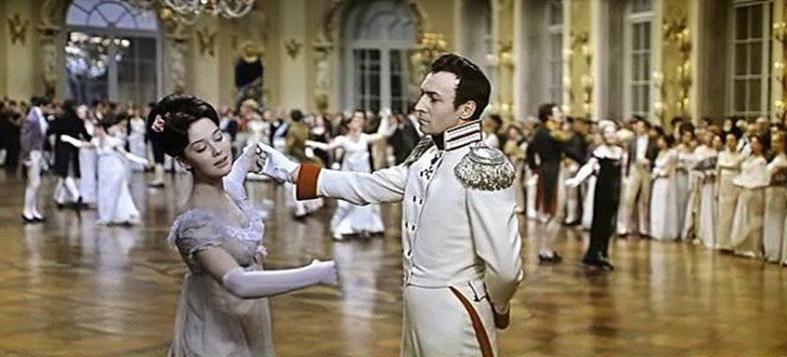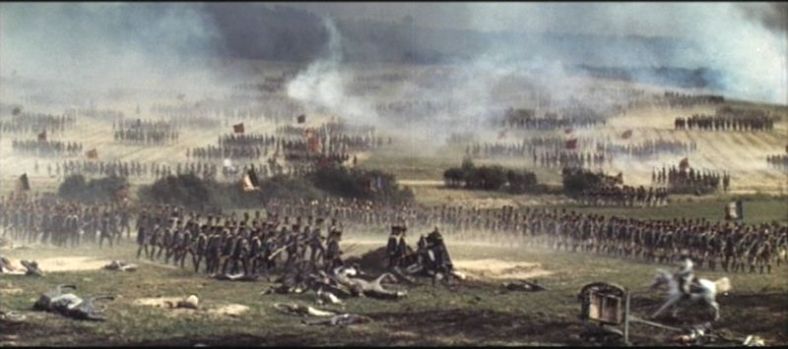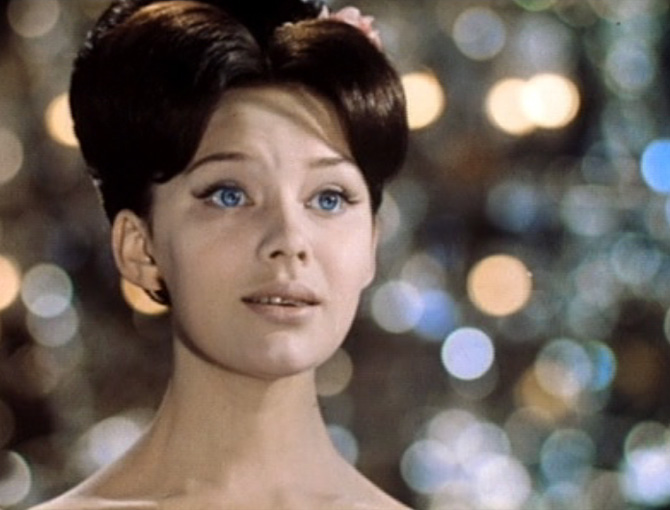
WAR AND PEACE —quite a few films qualify as ‘epic’ or ‘spectacular’ and of course today’s CGI allows stupendous effects creations that simply can’t be replicated otherwise. A lesser number, mostly pre-computer, go bigger on the old-school boggle scale to be deemed ‘mammoth’ or ‘colossal’. The mid-60s Russian version of their emblematic national novel marches a titan’s step further, into the rarefied category of the truly Monumental.
Russia, the early 1800s. Ill-fitting romantic choices bring misunderstanding and woe to the aristocratic Bolkonsky and Rostova families, specifically to respective members Andrei and Natasha. Lending moral support is their mutual friend, the intellectual, philosophical but naive Pierre, who also chooses the wrong mate. Hearts not wounded enough, Napoleonic France invades, twice, further sundering their lives and countless others.
Pride piqued, patriotism prodded by the 1956 Italo-American version, the Soviet government lent wholesale support to their country’s cinema community in order to answer and surpass the big, decent but truncated Western take. With some jostling in the Khruschevian establishment, directorial reins were given to 40-year-old Sergei Bondarchuk, a popular actor who’d directed one film in 1959. Co-writing with Vasily Solovyoy, he began filming in September of 1962 and concluded in August, 1967 (fitting enough, as it took Tolstoy six years to write the book). The titanic effort was divided into four separate features, released in ’66 and ’67, making its way to the US by 1968. It took the Oscar for Best Foreign Film as well as a cursory nomination for Art Direction. *

“Enough, enough, men. Stop, consider, what are you doing? Into the minds of tired and hungry men on both sides, a flicker of doubt began to creep. Were they to go on slaughtering one another? Kill whom you like, do what you like, but I’ve had enough. Yet some inexplicable, mysterious power continued to control them, and the terrible business went on, carried out not by the will of individual men.”

The four parts: Andrei Bolkonsky, 140 minutes, Natasha Rostova, 93 minutes, 1812, 78 minutes, Pierre Bezukhov, 92 minutes. All told, 403 minutes, 6.7 hours. Bondarchuk not only directed and co-wrote, he starred as Pierre. The effort nearly killed him, twice: he had two episodes of cardiac arrest, and was briefly clinically dead each time. As Natasha, ballerina Lyudmila Saveleva made her film debut. Born in 1942 during the siege of Leningrad, she was 19 when the movie began, with no acting experience, 25 when it finished. Vyacheslav Tikhonov took the role of Andrei. 

At least a thousand professional artists, designers, decorators and museum specialists worked on sets construction, design, and decoration, with over forty museums and numerous companies in Moscow and Leningrad donating or making countless replicas of uniforms, period dresses and assorted costumes, art, jewelry, cutlery, guns, vehicles and myriad props during the years of production. When the soldiers arrive, they come in the thousands, and 1,500 horses were harnessed up.
While costs and cast tallies were mis-reported and expanded beyond what was actually lavished (the best estimate/adjusted expenditure seems around $9,213,000 then/ $75,000,000 today), it’s safe to say, by any standard, and just using your eyes, that it dwarfed/dwarfs anything involving real flesh & blood people (not CGI orc hordes) ever put on film. **

Purists (even the word smells) take issue with the script leaving out much of Tolstoy’s ruminations on history and philosophy (choice of stance constricted in the USSR), and reduction of subplots, while expected killjoys—hovering around any and every event like flies—grouch about the running time and somewhat irksome dubbing. Start the book, 1,351 pages: telegraph me when you finish. Or just invade Russia, which would be shorter.
Stick with the subtitles to best savor the language. Luxuriate in the sweep, depth and breadth of this titan, one that, unlike most spectacles, takes time for the characters, in between the stunning set-pieces, to actually have lengthy conversations about ideas.
In his mid-40s, Bondarchuk’s buffeted Pierre was twice as old as the novel’s young man (Henry Fonda in the earlier version was 50), but he skillfully crafts a properly touching job out of the lumbering, sad and decent conscience of the piece. Tikhonov’s Andrei calmly suggests gallantry and pride, duty and rue. The lovely Saveleva’s Natasha is the personification of effervescent innocence, and later, psychically shattered despair, then resilient spirit—she’s a superb choice.

The lush, rolling countryside is framed in a hunt, a duel and immense battles: the more than 100 sets play host to family squabbles, mad drunken revelry, plaintive folk songs, and a vast and glittering ballroom dance with five hundred extras in elaborately detailed costumes that tops any similar soirée ever captured. Ultimately there is the hellfire of Moscow aflame, a riot of frenzied looting, roaring flames and mob rule. Finally, the agonized frozen retreat, glory’s gift to wolves and crows.

Towering over all is the staggering, gasp-worthy recreation of the ghastly Battle of Borodino. Bondarchuk marshaled 13,500 troops and more than 800 horses: filming the 33-minute sequence took three months. Cutting between vast panoramas of clashing regiments and furious individual bouts, the choreography, editing, score, sound, special effects and breath-taking camerawork build to a mighty and exhausting crescendo that pulls up into what seems literally a God’s-eye view of futile and eternal human folly.

The strong music score—suitably awesome and moving—came from Vyacheslav Ovchinnikov, a prodigy who began composing at the age of nine. The rich, dense, glimmering, often thrilling and sometimes outright astounding cinematography was the work of Iolanda Chen, Anatoliy Petritskiy and Aleksandr Shelenkov.
With Anatoli Ktorov as ‘Nikolai Bolkonsky’, Vasili Lanovoy and Irina Skobtseva (Bondarchuk’s wife, playing Pierre’s). Boris Zakhava embodied General Kutuzov, Vladislav Strzhelchik made an understandably baleful Napoleon.

“On 12th June, 1812, the forces of western Europe crossed the frontiers of Russia and war began. In other words, an event took place that was contrary to all human reason and human nature.”

* Yu vant beeg? As if it wasn’t gargantuan enough, period sources erroneously had it costing much more ($100m) and employing literal divisions of extra extras (120,000, which would have jeopardized the Red Army) than it actually did. Later, director Bondarchuk would deploy more bodies re-staging Waterloo, while Gandhi holds the tally-ho for the most humans ever used in one sequence (300,000 give or take). Red Cliff, China’s dazzling National Battle Epic, is no slacker. Modern budgets are so astronomical and indefensible that they kick over historical game-boards like petulant children; they hold dicey comparative relevance to movies made in the days when “a cast of thousands” meant persons rather than pixels. The CGI wonders of The Lord Of The Rings, Troy, etc., are truly fab, but for expended effort, genuine grandeur and bang-for-buck (or ruble), there has never yet been anything to match the astonishing War And Peace.
The monstrous real thing, of course, was a terrible chapter to behold. 300,000 men took part in the Battle of Borodino on Sept.7, 1812. More than 74,000 were killed or wounded (a wound back then usually meant imminent death), one of the bloodiest days in history. Napoleon surged into Russia leading a seemingly invincible Grand Armee of 600,000. When the starving survivors limped out they numbered but 26,000. Two Maxims of War: (1) don’t invade Russia and (2) don’t invade Russia.
** Oscar Schmoskar: The win for Best Foreign Film was a “Da!/duh?”, but…only one other measly nomination? If things were fair (no Vietnam War, no US/USSR standoff, no studios pushing their atrophied ten-ton musicals) the mighty War And Peace deserved Best Picture, Director, Cinematography, Art Direction, Costume Design, Sound, Music Score, and at least a nomination for Ms. Saveleva. “Nostrovia!”


*
This sounds epic! I am very eager to see this one now. Modern directors should learn from the classic era directors about how to do epic filmmaking. CGI often looks fake, nothing can beat doing crowd scenes/stunning backdrops for real.
It will leave you agog.